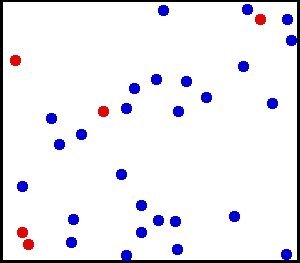
Caption: An animation of gas molecule motion at finite temperature.
Features:
- This is a cross section
of a cubical box.
- The number of molecules is N = 32
and say the length of a box side is L = 3. So the
number density
n = N/V = N/L**3 = 32/27 ≅ 1.2 .
-
The macroscopic effect of the collisions
of the molecules
is
pressure---which is
force per unit area.
Pressure in solids and liquids is different. It originates in the resistance to compression of closely packed atoms and molecules.
- Temperature, among other things,
is a measure of the kinetic energy
of the molecules.
The lower temperature, the lower the kinetic energy of the molecules.
- The
classical physics
formula for
kinetic energy is
KE = (1/2)mv**2 .
The classical physics absolute zero is when all the kinetic energies of the microscopic particles are zero: i.e., all the velocities are zero.The classical physics absolute zero (temperature) is the coldest since you CANNOT have less motion than none.
- The above statement about absolute zero
has to be modified for
quantum mechanics.
In quantum mechanics, there is a irremovable amount of kinetic energy called the zero-point energy.
In quantum mechanics, absolute zero (i.e., the coldest) is when you reach the zero-point energy.
- The Kelvin scale
for temperature
has its zero point
at absolute zero
which makes the Kelvin scale
the most useful temperature scale
for many formulae and calculations.
Image link: Wikipedia: File:Translational motion.gif.
Local file: local link: gas_animation.html.
File: Thermodynamics file: gas_animation.html.